1. Even the German Poet Goethe - a look at the history of pedagogy of cardboard modelling
Before I tell you something about the book I will give you some information about the history of pedagogy of carboard modelling. The assembly of a cardboard model already is an instructive/educational matter. You will learn for example something about a castle's construction, the architecure of a cathedral, about types of planes and ships. At the same time you will see the technique of working and train the manual skills which are important for the assembly and this will have positive effects on the intellectual development. Since several centuries the cardboard models are used explicitly as an educational method for imparting knowledge. I will show you two historical examples from the book "Cutted paper" by Sigrid Metken.
Even the seven-year-old Goethe learned geometry with the help of cardboard models. As expected from a genius he developed his own designs. Though he seemed to have no staying power, obviously it didn't lead anywhere:
"At an early age I had learned to use a pair of compasses and a ruler by turning the whole geometry lessons into action, and working with cardboard could occupy myself highly. I didn't stay with geometrical figures, boxes and such things but invented nice houses which I decorated with pilasters, flight of steps and flat roofs; but I managed only a little." (Johann Wolfgang Goethe: Aus meinem Leben. Dichtung und Wahrheit, Werke Bd.IX, Hamburg 1955, I. Teil, Buch 2, S. 49, quoted by: Sigrid Metken, Geschnittenes Papier, München 1978, page 273)
In his memories the artist Kügelgen tells about an especially impressive educational presentation by his private tutor Senff on Christmas evening 1809: "...in the hall Senff had built the town Constantiople with small houses, places and mosques out of paper. There wasn't anything more tidy than this paper town. Thickly spread white sand indicated the land, blue sand the sea which was busy with small ships. When Senff had given an explanation in broad outline he remarked that Constantinople used to burn down often, and then he set fire to the first house of the suburb Pera. Soon the flame broke out, engulfed the next building and the whole street, branched to other streets, sprang into wells filled with spirit and spread over the whole town. In the end the seraglio was burned down whose numerous towers burst out a miniature fireworks, finishing the performance with a bang... of course we were eager to copy everything...The fortresses and towns we had until then only drawn as ground plans now rose to all dimensions of space and we gained various knowledge and skillfulness" (Kügelgen, 2. Teil, Kap. II, p. 57f, quoted by: Metken, page 273)
2. Moving Model Books
Now let's make a jump over nearly 200 years into the modern times. The English Arcturus Publications has published five non-fiction books for children and young persons, it includes a kit for making a mechanical cardboard model. The kit illustrates the book's contents concretely - and on the other hand the book shows the theoretical background of the kit. Both elements complement and intensify one another.
The subjects orientate themselves to the target group's interest in adventures: Mummies, Dinosaurs, the Odyssey, Vikings and Martians. Each book has 16 pages with text and black-and-white drawings and four pages with instructions plus 16 pages kit. The cover is made from cardboard and is colour printed. The kit - punched cardboard - is stitched in the middle."Model maker" of all kits is Keith Newstead. All books are printed in China and the costs are between 5.99 and 6.99 British pounds. They were published in 2000 and 2001.
All models are moved by cranks. The transformation of movement is caused in four cases by a crank slider, in one case by cams and pushrods. For the movement of separate parts of the models strips of cardboard are very important, they can be used as linkages.
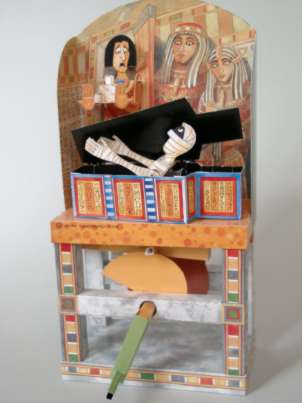 2.1 Mummies
2.1 Mummies"Mummies" was published for the first time in the year 2000 by Hodder Children's Books in London. The author is Philipp Steele, illustrator is Chris Mould. The text tells what mummies are, about the technique of mummifying, the Egyptian's belief in the hereafter, the gods, about tombs and pyramids, about archaeology and the Pharaoh's curse.
The cardboard model describes a situation in an Egyptian burial chamber or embalming room. A servant enters the room and wears a tray with bandages for wrapping a mummy. At that moment a coffin opens, the mummy sets halfway upright and the servant trembles with fear.
The mummies's drive: A snail cam slowly lifts a lever where a pushrod is fastened. The pushrod presses against the back of the mummy and puts it upright. At the same time the arms are lifted up as if they want to grab the servant. The coffin lid is pushed up by the raising mummy. Then lever and pushrod come down abruptly and so do mummy and coffin lid.
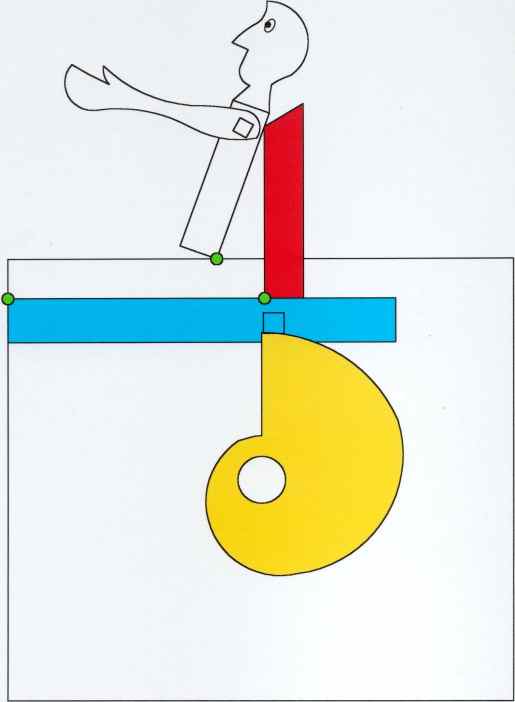
Drive of the servant: On a cam disc 17 small teeth are fastened which are nearly 40% of the circumference. Thereby a lever is moved up and down quickly slightly one after the other. The rattling movement is transfered on the lower part of the servant who is connected to the lever movably. The trunk is put over the lower part of the body loosely. The arms with the tray are fastened to the trunk movably. The tray is supported by a cardboard strip on the floor. Thereby the rattling of the tooth cam is transfered into the trembling of the servant.
 2.2 Dinosaurs
2.2 DinosaursThe book "Dinosaurs" was published in 2000, in co-operation with the Natural History Museum in London. The authoress is Belinda Weber, illustrator again Chris Mould. It describes some kinds of saurians and their circumstances of life in the Mesozoic. Two chapters deal with Triassic (228 million years ago), Jurassic (205 - 142 million years ago) and Cretaceous (142 - 65 million years ago), others show the "T-Rex - King of the Dinosaurs", fossils and the death of the dinos.
The cardboard model shows a Tyrannosaurus Rex that nibbles on a dead Dromaeosaurus. The mechanism is a crank slider, a lever that is connected to a crank at the lower end and to the body of the T-Rex at the upper end and so makes an up-and-down and a to-and-fro-movement. Tail, lower jaw and head also move. This is caused by cardboard strips as pushrods. The lower jaw is a double sided lever, a cardboard strip is fastened on its effort arm. When the T-Rex moves to the front and down, the strip presses the lever arm upright so that the jaws will open. The pupils of the T-Rex are drawn on the lower jaw, and in the head part the opening for the eyes is left blank. When the lower jaw opens up the pupils move as small strips to the front and this underlines the dangerous character of the beast.
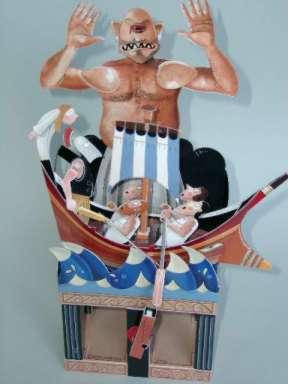
2.3 The Odyssey
The book was published in 2001, author of the text is Peter Weigall, the illustrator is Chris Mould.
The book shows eight adventures of Odysseus: the One-eyed Giant, the Bag of Winds, Circe's Spell, the Siren's Song, Scylla and Charybdis, Zeus' Punishment, Odysseus' Return, the Final Reckoning.
The cardboard model shows the flight of Odysseus and his men from the Cyclops. What has happened ? The Cyclops has caught Odysseus and his men in his cave. Because human flesh was the favourite meal of the Cyclops, they were his living food reserves. Odysseus - who was cunning - made the Cyclops drunken. While he slept it off Odysseus and his men drove a sharpened stake into his one eye. Because he was blinded now they could escape.
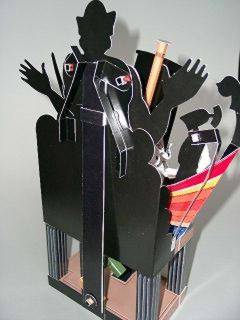 The model is moved by two crank sliders. One of them makes
the ship dance on the waves, the other controls the Cyclops. The highest
points of the movements are contrarotating: when the ship dives the Cyclops
straightens up to his full height and the other way round. The movements
are varied. The Cyclops moves trunk and arms, the ship dances on the waves,
the rowers lean back and forth and Odysseus raises his sword ready for
defence.
The model is moved by two crank sliders. One of them makes
the ship dance on the waves, the other controls the Cyclops. The highest
points of the movements are contrarotating: when the ship dives the Cyclops
straightens up to his full height and the other way round. The movements
are varied. The Cyclops moves trunk and arms, the ship dances on the waves,
the rowers lean back and forth and Odysseus raises his sword ready for
defence.Important for the movement of the Cyclops' arms and Odysseus and the movement of the rowers are cardboard strips that are fixed both to the moved part and the immovable parts as base and background. The limbs are lengthened over the fulcrum of the joint, so that you get a double-sided lever or bell crank lever. When the trunk of the Cyclops is raised by a crank slider the cardboard strips pull and the arms raise.
 2.4 The Vikings
2.4 The VikingsThe book was published in 2001, authoress is Belinda Weber, model maker and illustrator is Keith Newstead.
It tells about the living conditions and habits of the Vikings (Feasts and flogging), about their wars (Monsters of the sea), their weapons and armours (the weapons of war), their series of robberies (Raiders to settlers), their rituals of burial (Death of a Viking) and their faith (Battle of the giants).
The cardboard model shows a Viking by his favourite activity: burning down a village and slaughtering its inhabitants. Two crank sliders are moving the Viking and the wall of flames in the background. Arms and head of the Viking are moved by cardboard strips - see the Cyclops' drive. The relation between trunk and lower part of the body is solved very well. The trunk moves up and down and to the side. It is made as a box which is open at the bottom. The lower part of the body is placed in this opening and is guided by the trunk when it moves to the side. When the trunk moves up and down the lower part of the body remains always on the ground.
 2.5 Aliens
2.5 AliensThe book was published first in the year 2000 by Hodder Children's Books, London. Authoress is Susan Pinkus, illustrator is Chris Mould.
The book reports about meetings with UFOs and aliens and brings up the question: "Are we alone?"
The cardboard model shows a meeting between a Martian and an earthling who is sucked into the UFO. The construction is simple but remarkable. The drive is a crank slider, on its upper end the picture of an alien is glued. The lever runs in a guiding case which bears the spaceship. So the spaceship follows the lateral movement of the crank slider but not the up and down movement. The technical realization of the stroke movement of the sucked man is amazing. In the crank slider two parallel cardboard strips are glued which reach through an opening in the movable case to the front where the terrestrain is fastened. The opening works like a fulcrum for these cardboard strips which represent double-sided levers. When the crank slider goes down it pulls one end of the strip down while the other end with the man turns up and makes him disappear.
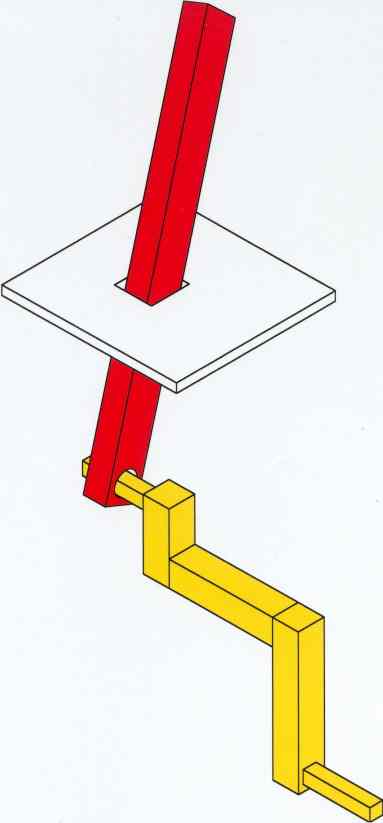
Scheme drawing of a crank slider which drives the models Dinosaurs, Odyssey, Vikings and Aliens. The rotation of the crank is transformed into a combined to and fro and up and down movement.
to the top